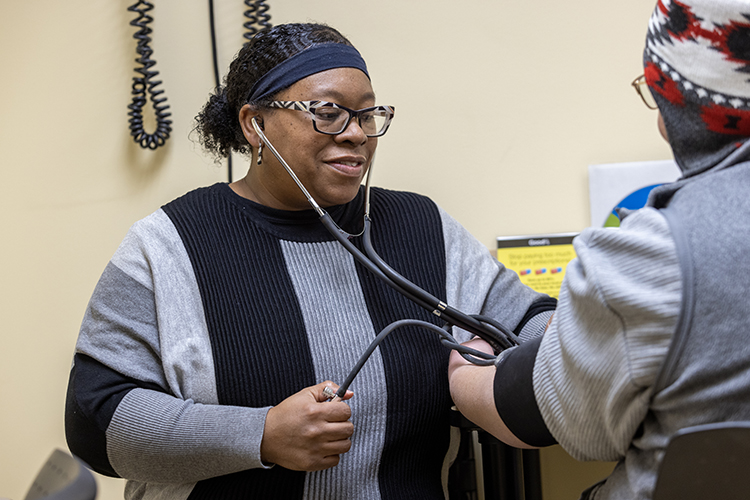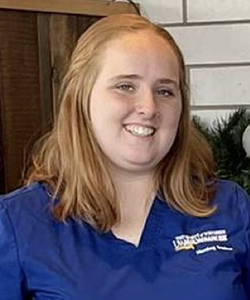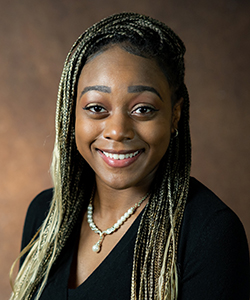
Erika Gainey, a senior nursing student, completed an internship last semester at the UWM Health and Wellness Center inside the House of Peace community center. Gainey and other UWM students take the opportunity to talk with residents who use the center about their health and how to improve it. (UWM Photo/Troye Fox)
Every Monday last semester, nursing senior Erika Gainey left her last class on campus and drove to the intersection of Walnut Avenue and 17th Street, where the Capuchin Community Service House of Peace sits in the heart of the 53205 ZIP code. There, she persuaded residents using the House of Peace to take a moment and get their blood pressure checked.
Gainey found that, for some people, a little health information can go a long way.
“It only takes five minutes to check someone’s blood pressure, but I talk to some of the clients for half an hour,” Gainey said. “When I sit down with them to talk about one health aspect, it sparks other conversations, like about their home life or other health concerns.”
Gainey’s weekly shift was part of an internship offered at one of several community locations throughout the city where UWM students help to teach people to take better care of themselves. At the House of Peace, faculty and staff have been providing health promotion to an underserved population with limited or no health insurance for more than 30 years.
“Our Health and Wellness Center at the House of Peace is just one unique way that our students can contribute to Milwaukee’s health care needs while also training for their careers,” said Kim Litwack, dean of UWM’s College of Nursing. “That engagement with the public is so important as the state faces a shortage of both nurses and other health care professionals.”
Helping address disparities
UWM’s Community Health and Wellness Center within the House of Peace is one of two centers where students are serving the community, gaining experience in the field and collecting data for research that addresses health disparities facing many Black Milwaukeeans. The other location is at the Silver Springs Neighborhood Center, adjacent to Westlawn Housing Project.

Health disparities arise when different populations do not have access to the same resources, leading to higher incidence of chronic diseases such as asthma, diabetes, hypertension and high cholesterol in low-income areas.
The beauty of having students work out of the House of Peace is that it is a hub for a variety of services, said Vanessa Baldwin, clinical instructor in the College of Nursing who supervises the students. In partnerships with the Hunger Task Force, House of Peace operates a food pantry. Some clients come to take advantage of the clothing donations. Once in the door, the student nurses offer blood pressure readings and give out information on the benefits of getting a flu shot, including where to get one.
“Once we check blood pressure, we can then explain to the client how changes to their diet or reducing stress can help lower their numbers,” said Maya Oezer, a senior nursing student. “And, we also gave health referrals so they know what to do next.”
Students in UWM’s physical therapy degree program also work at House of Peace, leading clients on walks and recommending exercises that address the client’s particular aches and pains.
Simple changes can help
Adrianna Thomas, a doctoral student in physical therapy, said it was gratifying to hear participants tell her they look forward to the group.

“We did simple things like bicep curls or overhead movement, just to get them moving,” Thomas said. “A lot of them aren’t aware of what exercises to do, and they’re often not aware of how important exercise is to their health.”
In addition to outreach, the students collected information on health behaviors from that ZIP code that feeds research into advancing health equity. By taking advantage of House of Peace giveaways, such as the dinners available to clients right before the holidays, the students could approach people standing in line. They asked questions about access to fresh food, health insurance and safe housing, and then recorded the answers on an iPad.
Gainey said this work requires time to build a rapport with people, and that’s why they are on site regularly.
“My experience at HOP pointed out that people need to be educated and shown what to do to change their health,” she said. “So even if I can reach just a few people, it’s worthwhile.”
Need to increase capacity
Litwack said UWM has the potential to bolster the health care talent pipeline in Wisconsin, but it needs more resources to increase capacity.
More than 1,400 nursing students are currently enrolled, including students at UWM at Waukesha who are earning their four-year degrees entirely at the Waukesha campus.
Another 2,000 students are enrolled in UWM’s College of Health Sciences, which offers programs in such as physical therapy, athletic training, biomedical technology and health care informatics.
UWM’s goal is to complete renovations to the Northwest Quad complex on its Milwaukee campus so that all health science programs can be located in the same place, enriching the student experience and providing the necessary space to grow.
Written by Laura Otto
Link to original story: https://uwm.edu/news/uwm-students-take-health-care-into-the-community/
